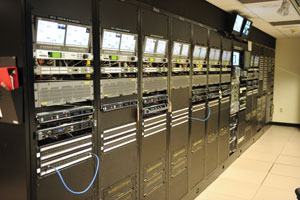QVC increases number of online content streams
Since its first U.S. telecast in 1986, video and e-commerce retailer QVC has added broadcast operations in the United States, Japan, Germany, the U.K., Italy and a joint venture with China. Its U.S. operation deploys three HD control rooms and more than 30 cameras to produce live programming 24 hours a day, 364 days a year.
Although QVC's production capabilities have always been strong, the options were limited when it came to master control.
The current configuration allowed the network’s signal to be viewed on multiple platforms, such as smartphones and tablets, as part of the QVC-Everywhere initiative. However, the content available on each device type was the same, as there was only one original stream.
The goal of the master control/NOC project was to expand playout capabilities to allow more content choices down the road, provide better monitoring of both outbound and return signals, and increase fault tolerance.

In the newly redesigned control room, Evertz monitors route the appropriate multiviewer outputs to one of 13 overhead displays, which are fed by a redundant analog Raritan KVM matrix.
Joe Micucci, director of broadcast engineering at QVC, was tasked with bringing this to fruition by November of 2012.
“We needed to be online and fully functional well before the holiday season,” said Micucci. “This meant that all training and issue resolution had to be completed before Nov. 1. Because QVC broadcasts live around the clock, the transition needed to be completely seamless.”
Get the TV Tech Newsletter
The professional video industry's #1 source for news, trends and product and tech information. Sign up below.
Design criteria
The goal was to replace the single, redundant master control system with multiple identical channels, some of which were to be redundant. All channels had to be 3G-capable and able to carry unique, independent content, or be capable of following the main channel.
Channels were divided into two categories: on-air and online. On-air channels would be inherently redundant, while online channels would be single-ended. Both were able to back each other up if needed.
Additional control positions and monitoring were required, allowing for multiple operators, as well as an overall supervisory position and comprehensive hierarchical fault reporting. The master control system needed to operate as an island, separate from production, with its own router for source selection and monitoring.
Equipment decisions
One of the difficulties during the design stage was selecting between baseband and IP-based master-control platforms. After careful evaluation, the network decided that the more traditional master control platform suited it best. A multi-segment network infrastructure was employed for device control, file transfer and SNMP reporting. Critical segments would be redundant as well, paralleling the X/Y concept

The network went with a traditional master control platform, with a Vizrt graphics engine and Evertz EQX ports for each channel physically mounted in individual racks to ensure channel redundancy.
Dalet is used for asset management in its production workflow, and the network decided to continue with Dalet to manage master control as well.
Playout architecture
Nine physical channels comprise seven playout streams. All channels are identical and can be used for any playout purpose. Each channel’s equipment complement is physically mounted in its own rack, to provide channel redundancy, growth space and isolation for troubleshooting purposes.
Primary channels are designed using the “X/Y” concept, whereby both halves operate in parallel from beginning to end, yet share no critical equipment. Each channel has a dedicated graphics engine and server play ports.
The following functions comprise the new playout architecture:
- MC switching. The Evertz 3025EMC master control switcher is fed by two router outputs in a Background A/B configuration. It includes additional fill/key inputs for external graphics devices. All of the audio is embedded. The switcher also has internal logo and clip playback capability with DVE squeeze and tease. The outputs of the switcher feed an air path chain consisting of a closed-caption encoder and frame sync, with a built-in loudness monitor and gain control.
- Bypass selection. An Evertz EQT-1602 Clean and Quiet is the final output of each channel and feeds the transmission path via a primary and secondary encoder Channel A router output.
Although all sources are synchronous, only a few are actually in time; the Clean and Quiet option allows hitless source selection regardless of timing. Control of the bypass switchers is completely independent of any other system, and relies only on a coax bus to panels located in the control room. Each operator position has a control panel for every channel. - Routing and router control. An Evertz EQX router is the heart of the master control system. Inputs are comprised of about 50 percent sources for air, and 50 percent master control monitoring points. The system uses three crosspoint cards: two as main and backup for normal router operations, and a third to feed the 14 VIP-X multiviewers. (Evertz has now combined router and multiviewer controls into one unit, called the MAGNUM.) Redundant MAGNUM servers increase fault tolerance and allow for hardware upgrades.
- Monitoring. Monitoring is done via 14 multiviewers, two per channel, which are fed back into the router as HD-SDI. Multiviewer outputs are assigned per channel and do not change. This offers the advantage that multiviewer outputs don’t have to be redrawn, and can be monitored at all times by anyone with a router output. Monitors in the control room simply route the appropriate multiviewer outputs to one of 13 overhead displays or four QC stations. Selecting a channel on a switcher control panel triggers a macro, which automatically routes the appropriate multiviewers to that position’s monitors. All monitors are routable, including computer displays, which are all fed by a redundant KVM matrix.
- KVM switching. Redundant Raritan analog matrices are used to switch KVM ports of any computer to any of 12 control points. Matrix outputs are distributed equally among operator positions. A matrix failure would reduce simultaneous access, but each operator would still have access to every computer on the system. An added benefit of the KVM system is that it allows CPU sharing. Two users can simultaneously monitor any computer, and control it in an arbitrated fashion.
An analog system was chosen over KVM-over-IP, because it allowed isolation from the data network, and was compatible with a similar system in use on the production side of the operation. - Graphics. Each channel has its own dedicated Vizrt graphics engine controlled by Dalet automation.
To allow for future possibilities, a Vizrt Multichannel system has also been installed, providing multi-format, template-based, automated graphics insertion across multiple engines. - Servers. Each channel has a dedicated Omneon Spectrum MediaPort. Storage is redundant and shared among MediaPorts. Content is pushed to the servers from the production server system via Dalet’s Media Asset Management.
- Encoding. The new master control system uses Haivision’s KulaByte encoders, with each encoder capable of accepting two HD-SDI inputs. Each MC channel is distributed to at least two encoders.
- Fault management. Skyline Communications’ DataMiner is used for fault monitoring and control of much of master control. The network has also moved its production distribution equipment to DataMiner, monitoring existing Miranda and Evertz devices and some satellite systems. The system allows operators to receive tailored messages on the severity of any problems, and helps them to quickly identify the ultimate fault.
- Networking. A stack of 10 Cisco Catalyst switches serves as the backbone of the networking infrastructure. Critical network segments are redundant. Using different subnets, they are physically wired to separate switches, but because of the stacking, any port on a switch can be assigned to the V-LANs as needed.
Channel launch
The system launched on schedule, supporting four channels in November of 2012. Today, it’s been expanded to five channels and is performing well.
Design team
- QVC: Jennifer Bonsall, business architect; Wayne Chmieleski, broadcast proj. mgr.; Greg Gialloreto, dir., proj. eng.; Joe Pendyck, mgr., live graphics; Joe Urzillo, sr. mgr., broadcast sys. eng.; George Dolphin, broadcast eng. architect; James Marquette, sr. broadcast eng. architect; Victor Florio, mgr., master control and network ops.; Patrick Schumaker, proj. eng.; Kenneth Torres-Zickler, broadcast sys. eng.
- Beck Associates: Paul Kast, VP of eng., east. reg.; Matt McMurray, sr. proj. mgr.
Equipment at work
- Beck Associates: Turnkey systems integration
- Cisco: Catalyst switches
- Dalet: Automation
- Evertz: 3025EMC master control switchers, EQT-1602 Clean and Quiet bypass switchers, EQX 3G/HD/SD/ASI routers, VIP-X 32 x 2 multiviewers, MAGNUM router and multiviewer control
- Haivision: KulaByte encoders
- Image Video: TSI-3000 (tally)
- Omneon: Spectrum MediaPort servers
- Raritan: Paragon dual 64 x 16 KVM routing
- Skyline Communications: DataMiner
- Vizrt: Multichannel graphics insertion system
—Paul Kast is VP of engineering, eastern region, for Beck Associates.
